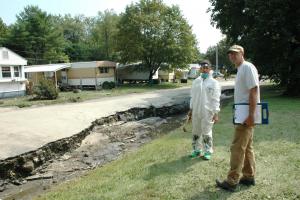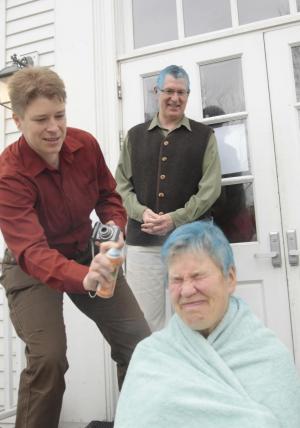Marlboro responds to flood damage
The Marlboro community will not soon forget the day in late August when Tropical Storm Irene destroyed local roads and cut the college off from the rest of the world for days. But perhaps more remarkable than the college’s resilience during and after the storm was the response to neighboring communities where the flooding wreaked even more havoc.

As early as September 3, just a week after the storm, a group of 21 Marlboro students and staff participated in the United Way Day of Caring. This was an event planned long before the flooding, and most of the projects for large groups did not directly involve flood relief. However, the outpouring of support was essential to the nonprofits that provide much-needed programs in the region, and a boon to the local efforts of the United Way. Marlboro students helped scrape and paint facilities at Green Mountain Girls Camp in Dummerston, Farming Connections in Guilford and Living Memorial Park Snow Sports in Brattleboro. Several students helped at Glen Park, on Western Avenue, a mobile home park for elderly residents that was damaged by floodwaters.
“It was one of the toughest, nastiest jobs anyone has had to face,” said Christine Forbes, whose 95-year-old mother, Alice Joslin, was one of the Glen Park residents helped by students. “Not only was the job completed, but they were so pleasant to her and made the job almost fun. I will long remember the happiness in her voice when she talked about these students. They were truly extraordinary young folks.”
The following weekend, as most of the local roads became passable, Marlboro’s new writing professor, Kyhl Lyndgaard, led a group of three students and one parent of a former student to the hardest-hit road in Marlboro, Augur Hole Road. There they helped remove silt from the residence that was once the Branch Schoolhouse.
“For all of us, the storm was a new and shocking experience,” said Kyhl. “But the washed-out roads have been more than matched by the resilience of Marlboro residents.”
On September 24, more than 70 students, faculty and staff joined together at Whittemore Theater to be part of the world’s largest poetry reading, 100,000 Poets for Change, an event that brings poets and other artists together to perform simultaneously around the world. The local effort, which directly supported United Way disaster relief and benefited victims of the storm, featured readings and performances by receptionist Sunny Tappan ’77, writing professor John Sheehy, senior Gina Ruth and junior Jack Rossiter-Munley, who organized the evening. It also included a silent auction and bake sale, and altogether raised more than $700 for local flood relief efforts.

Finally, a fund drive that started as a dare between two students ended with a total donation of $5,139 for the United Way of Windham County. When senior Anna Hughes offered to pay junior Chuck Pillette to dye his hair blue, they decided to up the ante and raise money for those affected by the flooding as well as others in need. Jodi Clark ’95, director of housing and residential life, was planning the traditional employee fundraising effort for the United Way when Anna asked for help getting her campaign going.
“It simply seemed like a great way to accomplish both the employee campaign and this student-led idea by combining them to make it a whole campus community campaign,” said Jodi. The resulting “Green for Blue” fund drive involved 17 prominent community members who promised to dye their hair blue if donations reached a certain level. While the campaign raised just $500 less than the goal of $5,000—the point at which Marlboro President Ellen McCulloch-Lovell pledged to go blue—a final push by faculty and students at the graduate school brought the total above that mark.
